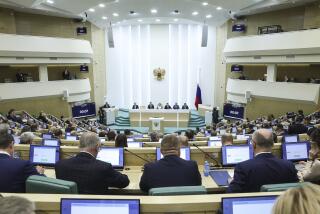Soviets Conduct Second A-Test in Two Weeks
- Share via
MOSCOW — The Soviet Union today conducted its second underground nuclear blast in the two weeks since the Kremlin abandoned its 19-month unilateral testing moratorium.
Moscow also denied U.S. claims that its first test violated treaties by releasing radioactive fallout.
Tass press agency said today’s blast had a yield of 20 kilotons, or 20,000 tons of TNT, and was conducted “with a view to upgrading military technology.”
It occurred at 5 a.m. Moscow time at the military testing site at Semipalatinsk, in the Central Asian republic of Kazakhstan, about 1,800 miles southeast of Moscow.
The announcement came a day after the State Department said the last Soviet underground test, conducted Feb. 26, released a small amount of radioactive debris into the atmosphere in violation of the 1963 Limited Test Ban Treaty. The State Department said there was no health danger.
The treaty bans the release of radioactive materials over national borders during testing.
A spokesman for the Soviet Foreign Ministry called the State Department charges a lie.
“There is not a grain of truth in the State Department’s assertions,” Boris Pyadyshev said. “What it says is a gross falsification and a lie. The explosion set off in the Soviet Union in February was made with the observance of all safety requirements.”
Today’s blast is considered relatively small and well under the 150-kiloton limit set up by the 1974 threshold treaty.
In a commentary on the test, Tass said the Soviet Union conducted the test because of the “reckless militaristic position of Washington,” which refused to join the testing moratorium.
More to Read
Sign up for Essential California
The most important California stories and recommendations in your inbox every morning.
You may occasionally receive promotional content from the Los Angeles Times.










